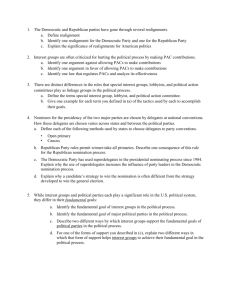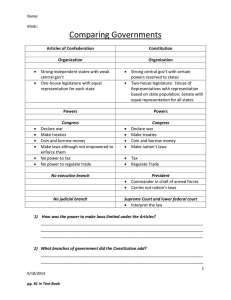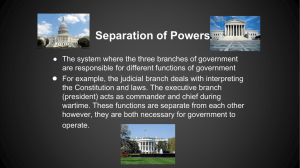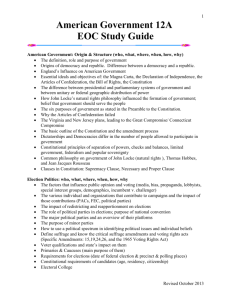AP FRQs
advertisement
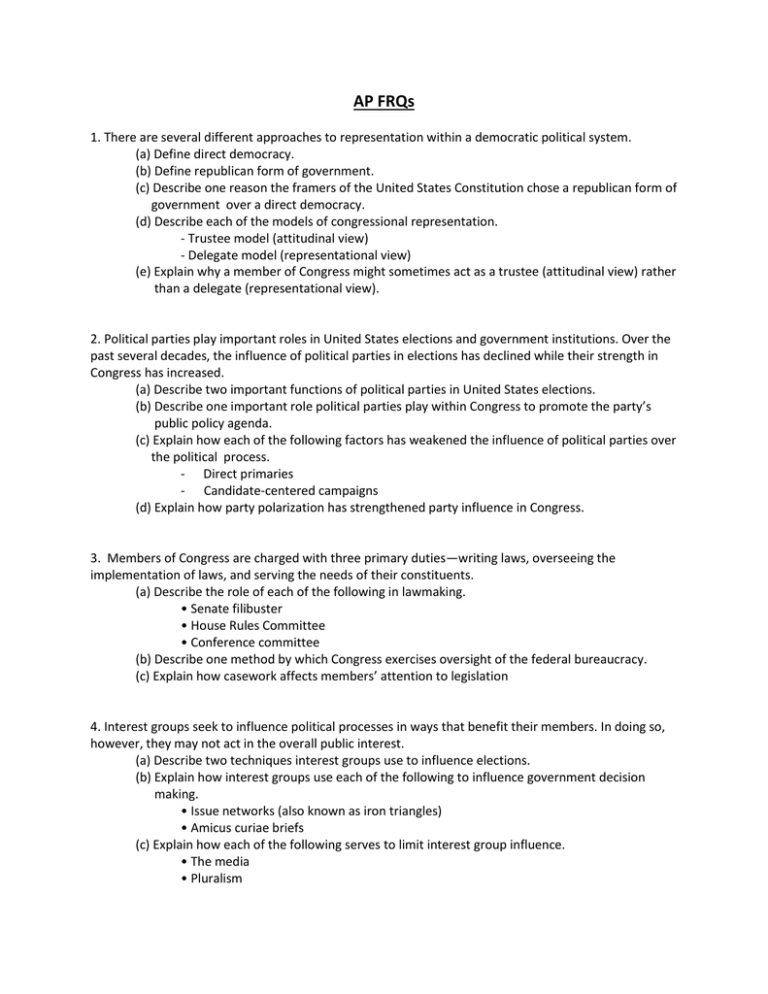
AP FRQs 1. There are several different approaches to representation within a democratic political system. (a) Define direct democracy. (b) Define republican form of government. (c) Describe one reason the framers of the United States Constitution chose a republican form of government over a direct democracy. (d) Describe each of the models of congressional representation. - Trustee model (attitudinal view) - Delegate model (representational view) (e) Explain why a member of Congress might sometimes act as a trustee (attitudinal view) rather than a delegate (representational view). 2. Political parties play important roles in United States elections and government institutions. Over the past several decades, the influence of political parties in elections has declined while their strength in Congress has increased. (a) Describe two important functions of political parties in United States elections. (b) Describe one important role political parties play within Congress to promote the party’s public policy agenda. (c) Explain how each of the following factors has weakened the influence of political parties over the political process. - Direct primaries - Candidate-centered campaigns (d) Explain how party polarization has strengthened party influence in Congress. 3. Members of Congress are charged with three primary duties—writing laws, overseeing the implementation of laws, and serving the needs of their constituents. (a) Describe the role of each of the following in lawmaking. • Senate filibuster • House Rules Committee • Conference committee (b) Describe one method by which Congress exercises oversight of the federal bureaucracy. (c) Explain how casework affects members’ attention to legislation 4. Interest groups seek to influence political processes in ways that benefit their members. In doing so, however, they may not act in the overall public interest. (a) Describe two techniques interest groups use to influence elections. (b) Explain how interest groups use each of the following to influence government decision making. • Issue networks (also known as iron triangles) • Amicus curiae briefs (c) Explain how each of the following serves to limit interest group influence. • The media • Pluralism 5. Nominees for the presidency of the two major parties are chosen by delegates at national conventions. How these delegates are chosen varies across states and between the political parties. a. Define each of the following methods used by states to choose delegates to party conventions. • Open primary • Caucus b. Republican Party rules permit winner-take-all primaries. Describe one consequence of this rule for the Republican nomination process. c. The Democratic Party has used superdelegates in the presidential nominating process since 1984. Explain why the use of superdelegates increases the influence of party leaders in the Democratic nomination process. d. Explain why a candidate’s strategy to win the nomination is often different from the strategy developed to win the general election. 6. The Constitution of the United States creates a government of separate institutions that share power rather than a government that delegates power exclusively to a single branch. Frequently, this means that presidents and Congress struggle with each other. a. For each of the presidential powers below, explain one way that congressional decision making is affected by that power. • Veto power • Power to issue executive orders • Power as commander in chief b. For each of the congressional powers below, explain one way that presidential decision making is affected by that power. • Legislative oversight power • Senate advice and consent power • Budgetary power 7. The framers of the Constitution created a political system based on limited government. The original Constitution and the Bill of Rights were intended to restrict the powers of the national government. Later constitutional developments also limited the powers of state governments. (a) Explain how each of the following limits the powers of the national executive. • Federalism • Checks and balances (b) Explain how each of the following two provisions in the Bill of Rights limits the powers of the national government. • Establishment clause • Guarantee of a public trial (c) Choose one of the following and explain how it limits the power of state governments. • Citizenship clause of the Fourteenth Amendment • Selective incorporation 8. In The Federalist paper number 10, James Madison expressed concern over the possibility that both majority and minority factions would have too much power over government, and he presented ways of minimizing that danger. The United States Constitution established a democratic government but also contained several provisions that limited majority rule. Throughout the next two centuries, the role of majority rule in the United States government and politics continued to change. (a) Identify the part of the national government that was originally most closely tied to citizens and explain how it was tied to citizens. (b) Explain two ways the United States Constitution limited majority rule. (c) Choose two of the following twentieth-century developments and explain how each moved the United States from a less democratic system to a more democratic system. • Primary elections • The Seventeenth Amendment • Expansion of suffrage


